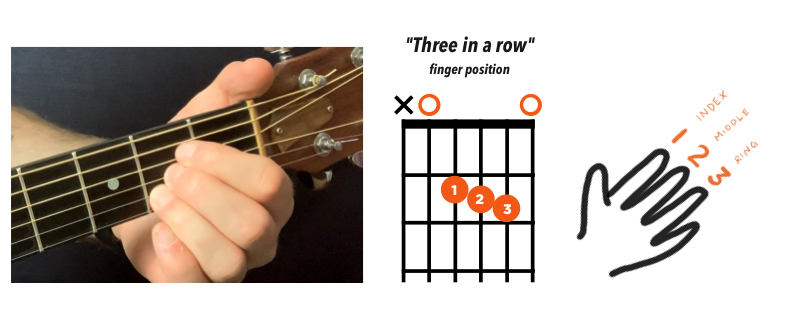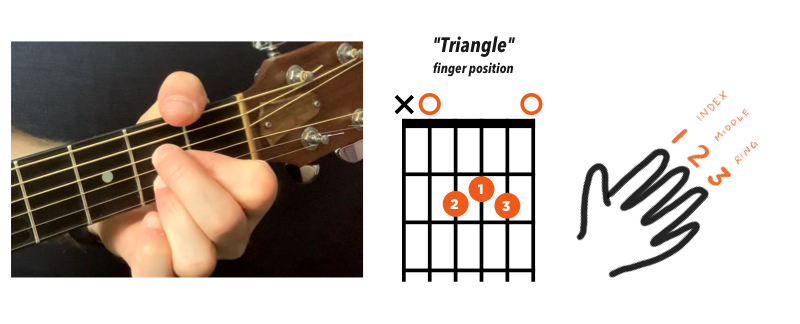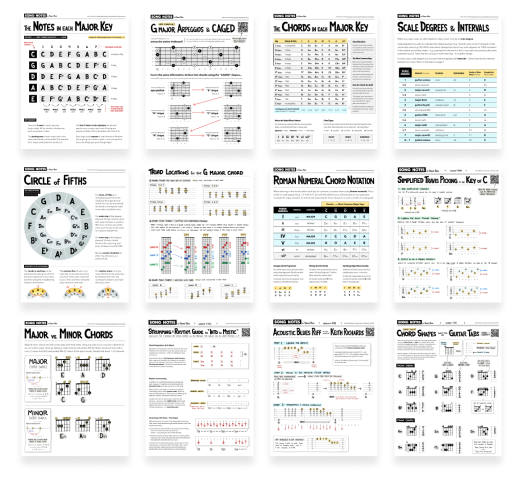Playing A-major with big fingers or a small fretboard
Lesson #194 • Nov 27, 2018
Video Overview
Instructional PDF 2 pages
Editor’s notes
Ever have trouble getting your fingers crammed together to play the A-major chord? You’re not alone! Here’s a simple technique you can use - where a simple tweak of your finger position can create a lot more breathing room for all of your fingers. Not only does this make the chord easier to switch to, but it actually makes certain common transitions (do D-major and E-major) easier than they were before.
The “normal” way to play A-major
Usually, A-major is taught (and played) like this. Three fingers in a row, all on the 2nd fret. This may well be good enough for you – especially if your fingers aren’t huge, or if you’re playing on a large enough guitar.

However, a challenge with this finger positioning is things can get crammed when your fingers are in a straight line like this. For me, I have very little wiggle room - it’s quite frankly not comfortable. Luckily, there is another way…
The “triangle” way to play A-major
Here, we’re playing the same notes - but we’re using our left-hand fingers in a different way. Notice how the index finger is in the middle of the 3 notes, instead of on the far side. This creates a triangle shape, which actually allows for much more wiggle room around each finger. The result is a chord that’s quicker to switch to and more comfortable to play.

Easy transitions between A, D, and E
A straight-up benefit for playing A-major in this manner, is your index finger will be on the same string that it’s used on the D-major and E-major chord - both of which are very frequently played along with the A-major chord. See my video for reference - switching between these three chords is a breeze when your index finger doesn’t have to ever change strings.
E –––0––––2––––0––––
B –––2––––3––––0––––
G –––2––––2––––1–––– <== left index finger is used on this
D –––2––––0––––2–––– string for all 3 chords (good!)
A –––0–––––––––2––––
E –––––––––––––0––––
A D E
You can still play Asus2 and Asus4
Finally, a nice benefit of this chord voicing is that you can still play the common Asus2 and Asus4 chords just as you did before. Meaning, you’re using your left-hand pinky for the Asus4’s 3rd fret note - which feels 100% natural.
E –––0––––––0––––––0–––––
B –––2––––––3––––––0–––––
G –––2––––––2––––––2–––––
D –––2––––––2––––––2–––––
A –––0––––––0––––––0–––––
E –––––––––––––––––––––––
A Asus4 Asus2
Good luck!
I hope this was helpful for you. As always, it’s best to see my video lesson for reference. Please let me know what questions you have, and until next time - best of luck!
Enjoy My Lessons? Show Your Support!
Most of the lessons on my website are 100% free. If you have the means, please show your support with a tip jar contribution. I put many hours into every lesson — but it only takes you a minute to make a donation. You have my thanks!
Looking for More Song Lessons?
Featured Courses
Fun & Helpful Tools I've Made
Coming soon is Jambox – which shows all the video jam tracks I've made. It's note quite ready for the spotlight, but check it out if you like!
Subscribe to my YouTube channel
Be sure to never miss a lesson by subscribing on YouTube. I put out 2-3 new videos every week. These include full song lessons, as well as covers, practice tips, behind-the-scenes updates. Thanks!
Recent Lessons
-
Dec 19, 2025
"Fairytale of New York" by The Pogues
-
Dec 12, 2025
"The Christmas Song" by Nat King Cole
-
Dec 4, 2025
"If I Needed You" by Emmylou Harris & Don Williams
-
Nov 21, 2025
Learn to Play "Hey Joe", Step-by-Step
-
Nov 15, 2025
Songs Using the One-Four-Five Chords
-
October 31, 2025
"Long Cool Woman (In a Black Dress)" by The Hollies
-
October 24, 2025
"Dust in the Wind" Intro Fingerstyle, Step-by-Step
-
Oct 18, 2025
"America" by Simon & Garfunkel
-
Oct 8, 2025
Rhythm Deep-Dive: "Wild World" by Cat Stevens


